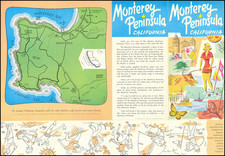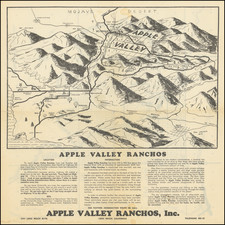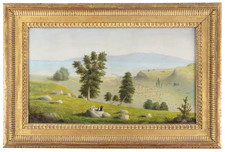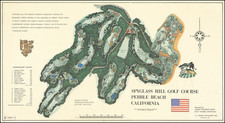Fine large map of the area around the Stockton Waterfront, drawn to illustrate proposals for the improvement of Stockton's Water front.
The map is exceptional for its detailed depiction of waterfront commerce in Stockton at the end of the 19th Century. At the top left, the proposed harbor has been drawn in, overlaid onto existing streets, etc., giving a view of how the city proposed to change the east end of the Stockton Channel to create a harbor and redesign existing streets, etc.
Sandwiched between the Mormon Channel and the Stockton Channel and its proposed harbor, the beating hear of Stockton's shipping and rail industries is laid out by name, including:
- The Wharf and Cattle Pens of the San Francisco & San Joaquinn Valley Railroad Company
- The Coal Bunkers and other property of the Alameda & San Joaquin Railroad Company
- The warehouses of the Farmers Union & Milling Company and C. N. & I Company and shipyard.
- The warehouse and flour mill of the Stockton Milling Company
- Land of the Southern Pacific Railroad Company
- Various other Warehouses, Lumber Yards and Flour Mills
- Land owned by the heirs of Charles Weber (founder of Stockton)
- 2 Steamboat sheds
- The land of J.F. Devendorf and E.L. Wilhoit
- The land of the F.U. and D.M. Company
Further south, along the Buell Canal, the land owned by P.A. Buell & Co, and the San Francisco & San Joaquinn Valley Railroad Company is shown. Other major landowners named include:
- Stockton Woolen Mills
- R.C. Sargent
- Martin Stein Warehouse
- Stockton Gas & Electric Works
- Stockton Warehouse Company
- Stockton Lumber Company
- Sperry Flower Mills
- Adair Welcker
- Jerome E. Young
- Bank of National City
- H.T. Compton
Stockton, with its strategic location on the San Joaquin River, has always played a crucial role in California's maritime history. Located nearly 90 miles inland from the San Francisco Bay, Stockton is uniquely positioned as an inland port. Historically, before the advent of modern transportation and communication methods, waterways were vital arteries for trade, transportation, and communication.
Founded in 1849 by Captain Charles Weber, Stockton quickly became a critical supply center during the Gold Rush. This newfound wealth and prominence made it an economic powerhouse in California. Goods and people moved in and out of the city primarily via water routes, with the San Joaquin River acting as the primary channel. However, given the river's twists and turns, which were not always conducive to efficient shipping, there were always dreams and visions of improvements.
The Mormon Channel, a slough south of downtown Stockton, played an important role in the city's early years. The Mormon pioneers, who had been evicted from their homes in the Midwest, made their way to Stockton and played a key role in its early development.
The "Map of the Waterfront of the City of Stockton Showing Proposed Improvements in the Alignment of the Waterfront and Adjacent Street and Property Lines" from February 1899 is a testament to the ongoing ambitions of the city leaders. Drawn up by H.T. Compton, the City Surveyor, the map demonstrates the city's forward-thinking attitude towards developing its waterfront. The proposed improvements sought to align the waterfront in a manner that would facilitate smoother shipping operations, reflecting the city's aspirations to remain a vital hub in the state's commerce.
The Stockton Ship Canal proposal of the 1870s epitomizes this ambition. Even though the Ship Canal did not come to fruition due to its prohibitive costs and the rise of railroad transportation, the vision behind it was clear: to firmly establish Stockton as a maritime powerhouse in California. It was not until the 120s when the Stockton Deepwater Shipping Canal was completed.
Stockton's journey from its early days as an essential supply center during the Gold Rush to its vision of becoming a maritime hub is a story of ambition, resilience, and adaptability. The maps and proposals of the late 19th century not only show a snapshot of the city's aspirations but also provide a window into the dynamic evolution of Stockton's history. Even though the era of canals and waterfronts has evolved with the rise of modern technology, the historical significance of these projects continues to leave an indelible mark on the city's identity.
















![(Coachella Valley, California) Check in at Indio Hub of the California Desert Playground [cover title]](https://storage.googleapis.com/raremaps/img/small/97327.jpg)